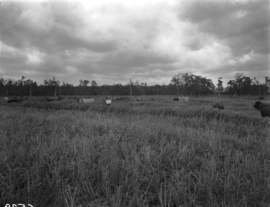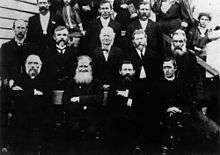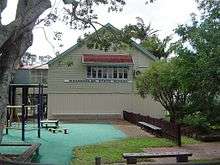Woongoolba, Queensland
Woongoolba is a coastal rural locality in the northern part of City of Gold Coast, Queensland, Australia.[2]
| Woongoolba Gold Coast, Queensland | |||||||||||||||
|---|---|---|---|---|---|---|---|---|---|---|---|---|---|---|---|
 Cattle grazing, Woongoolba, 1956 | |||||||||||||||
| Population | 460 (2011 census)[1] | ||||||||||||||
| Postcode(s) | 4207 | ||||||||||||||
| LGA(s) | City of Gold Coast | ||||||||||||||
| State electorate(s) | Coomera | ||||||||||||||
| Federal Division(s) | Fadden | ||||||||||||||
| |||||||||||||||
History


In the late 1800s, the farming district located between the Pimpama River and the Logan River called Pimpama Island and encompasses the modern localities of Jacobs Well, Norwell, Steiglitz and Woongoolba. It was referred to as an island because there were a number of lagoons and swamps that isolated the area during the wet season; however, this disadvantage made it good land for growing sugar cane.[3]
The name Woongoolba is believed to be an Aboriginal word for the geebung tree.[2]
The district was predominantly settled by German immigrants who arrived in the period 1864–1900.[4]
The Pimpama Island Provisional School opened on 17 April 1876 under the direction of teacher Joseph Schindler with 13 pupils (of German parentage). It became Pimpama Island State School on 7 September 1898. It was renamed Woongoolba State School in 1930. Additional classrooms and a library were built in 1941, with further expansions in 1991, 1997 and 2010.[4][5][6]
The Rocky Point Sugar Mill was established by Carl Heinrich Heck in 1878 on Mill Road (and crosses the boundary between Woongoolba and Steiglitz). Despite being one of the oldest sugar mills in Australia, it is still privately owned by the Heck Group. There were once other sugar mills in the area, but they have now closed and Rocky Point has expanded to replace their lost capacity.[7]
The Bethlehem Lutheran church was established in 1882; it is still operating in 2014.
In the 2011 census, Woongoolba had a population of 460 people.[1]
Amenities
Accessed via a causeway through the mangroves, the Cecil Zipf Park at Little Rocky Point offers views of Moreton Bay, off-leash dog area, BBQ and toilets. The beach below the park is a good place for fishing, especially for bream.[8][9]
The Gold Coast City Council operates a fortnightly mobile library service which visits Woongoolba State School on Jacobs Well Road.[10]
References
- Australian Bureau of Statistics (31 October 2012). "Woongoolba". 2011 Census QuickStats. Retrieved 4 April 2014.

- "Woongoolba (entry 46102)". Queensland Place Names. Queensland Government. Retrieved 4 April 2014.
- "Woongoolba History". City of Gold Coast Council. Retrieved 5 April 2014.
- "Agency ID 5847, Woongoolba State School". Queensland State Archives. Retrieved 5 April 2014.
- "Opening and closing dates of Queensland Schools". Queensland Government. Retrieved 4 April 2014.
- "History of Woongoolba State School". Woongoolba State School. Retrieved 4 April 2014.
- "A brief history – Carl Heinrich Heck". Heck Group. Retrieved 4 April 2014.
- "Cecil Zipf Park, Woongoolba" (PDF). City of Gold Coast Council. Retrieved 14 April 2014.
- Downie, Dave 'Nugget' (27 April 2012). "Fishing: Any bait will do for bream". Courier-Mail. Retrieved 14 April 2014.
- "Mobile Library 2018 timetable" (PDF). Gold Coast City Council. Archived (PDF) from the original on 30 January 2018. Retrieved 30 January 2018.